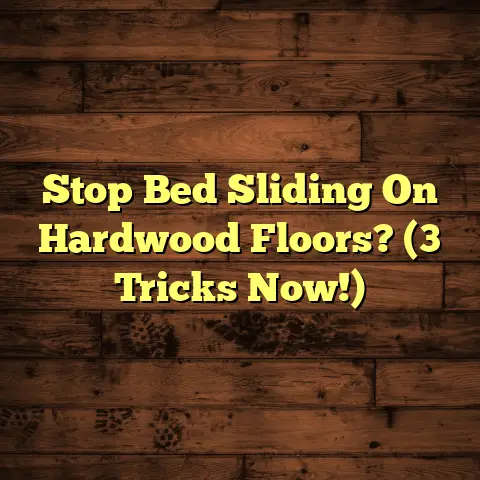Protecting Hardwood Floors From Heavy Furniture? (Explained)
Walking into a room filled with heavy furniture can evoke a sense of warmth and comfort.
But as a flooring contractor, I’ve often felt that pang of worry when I see my clients’ stunning hardwood floors hidden beneath the weight of their beloved pieces.
Over the years, I’ve learned that protecting these beautiful surfaces from the potential damage caused by heavy furniture is not just a matter of aesthetics; it’s about preserving value and ensuring longevity.
The Challenge of Heavy Furniture
In my experience, heavy furniture can lead to scratches, dents, and even warping if not managed properly.
A few years back, I worked on a project in a charming Victorian home.
The owners had purchased a massive antique dining table that weighed a ton.
I remember them asking me how to protect their newly installed hardwood floors.
It was a challenge that required some thoughtful strategies.
Heavy furniture can cause permanent damage to hardwood floors if not handled correctly.
The pressure exerted by items like sofas, cabinets, and beds can lead to unsightly dents and scratches, diminishing the beauty of the wood.
In fact, I recall one homeowner who didn’t take precautions when moving a heavy entertainment center.
The result?
A permanent indentation that marred an otherwise flawless floor.
The Importance of Furniture Pads
One of the simplest and most effective solutions I recommend is using furniture pads.
These little heroes come in various materials—felt, rubber, and plastic—and can make a significant difference.
I recall a client who moved their heavy sofa across their hardwood floor without any protection.
The result?
Deep scratches that took away from the floor’s beauty.
When I suggested adding felt pads to the legs of their furniture, they were amazed at how much it helped.
Felt pads are soft and provide a buffer between the furniture and the floor, reducing the risk of damage.
I usually recommend checking the pads every few months to ensure they remain in good condition.
Tip: To find the right-size pads, measure the legs of your furniture before heading to the store.
It’s also wise to choose thicker pads for heavier furniture pieces.
The Role of Area Rugs
Area rugs are another fantastic way to protect hardwood floors from heavy furniture.
I once worked on a project where the homeowner wanted to showcase her sleek coffee table in a spacious living room.
To protect the hardwood, we placed a large area rug beneath the table, which not only added warmth but also prevented any scratches or dents.
A quick tip: when choosing area rugs, make sure they are large enough to accommodate the furniture’s footprint.
Ideally, at least the front legs of the furniture should sit on the rug.
This not only looks visually appealing but provides better protection for your floors.
Rugs can also absorb shock when things are dropped and provide a comfortable surface for walking, which is particularly beneficial in high-traffic areas.
However, it’s essential to select rugs specifically designed for hardwood floors.
Some rugs have rubber backing that can actually trap moisture against your wood flooring if spills occur.
Caster Wheels: A Double-Edged Sword
Caster wheels can be both a blessing and a curse when it comes to protecting hardwood floors.
I once encountered a situation where a client had opted for a dining chair with hard plastic wheels.
They loved how easy it was to move the chairs around, but they didn’t realize the potential damage they could cause.
I advised them to switch to rubber or softer casters designed specifically for hardwood floors.
These types allow for mobility without causing scratches or dents.
If you have heavier items like office chairs or rolling carts, consider investing in high-quality casters that won’t compromise your floors.
Tip: Always check the weight rating for casters before purchasing; this ensures they can adequately support your furniture without damaging your floor.
The Weight Distribution Technique
Weight distribution is crucial when arranging heavy furniture.
I had a client who was thrilled about their new entertainment center but was concerned about its weight on the hardwood floors.
I explained how distributing weight can minimize damage.
For instance, placing furniture on larger platforms or using furniture coasters can help spread out the weight.
This simple adjustment can significantly reduce pressure points on your hardwood floor, preventing any potential warping or indentations.
In my own workshop, I often use plywood sheets as temporary platforms while rearranging heavy items.
This method not only protects my own flooring but also makes it easier to move bulky materials around without causing damage.
Maintenance and Regular Checks
Regular maintenance is key to keeping your hardwood floors safe from heavy furniture.
After installations, I often remind clients to routinely check for any signs of wear and tear.
This includes ensuring that furniture pads are intact, area rugs are clean, and there’s no moisture buildup underneath any pieces.
I recall one homeowner who discovered mold growth under an area rug because they hadn’t moved it for months.
This situation not only affected their flooring but also posed health risks.
By encouraging regular checks and maintenance, you can avoid such challenges.
Tip: Set reminders on your phone to check pads and rugs every few months; it’s a small effort that pays off in maintaining your beautiful floors.
The Importance of Proper Installation
Proper installation of hardwood floors can also play a significant role in how well they withstand heavy furniture.
When installing, I always emphasize the importance of acclimating hardwood planks to the environment before installation.
This process allows the wood to adjust to humidity levels and temperature, reducing future warping and movement.
Moreover, using quality underlayment during installation can provide an additional layer of protection against moisture while enhancing sound absorption.
Using FloorTally for Cost Estimation
When it comes to flooring projects, having accurate cost estimates is essential.
I rely heavily on FloorTally for this purpose.
It allows me to pull local material and labor rates quickly, so my clients know what to expect financially.
For example, during the Victorian home project mentioned earlier, I used FloorTally to present an accurate budget breakdown that included costs for protective measures like furniture pads and area rugs.
This transparency helped build trust with my clients, as they appreciated knowing exactly where their money was going.
Additionally, FloorTally’s budgeting tools help me plan for hidden costs that may arise during installation or renovation projects.
For instance, I once had to account for removing old carpeting before installing new hardwoods—a cost that wasn’t initially considered by the homeowners.
Comparing Different Protection Strategies
Over the years, I’ve tried various methods for protecting hardwood floors from heavy furniture, each with its own pros and cons:
- Furniture Pads:
Pros: Easy to apply and inexpensive.
Cons: Can wear out over time; requires regular replacement. - Area Rugs:
Pros: Aesthetic appeal; provides cushioning against heavy items.
Cons: May require frequent cleaning; can shift if not secured. - Caster Wheels:
Pros: Enhances mobility; available in soft materials for protection.
Cons: Hard wheels can cause scratches; requires careful selection. - Weight Distribution:
Pros: Minimizes pressure points on flooring; effective for large furniture pieces.
Cons: May require rearranging furniture; not always practical. - Regular Maintenance:
Pros: Prevents long-term damage; helps identify issues early on.
Cons: Requires time and effort; easily overlooked.
Additional Tips for Protection
- Avoid Dragging Furniture: Always lift rather than drag furniture when moving it across hardwood floors.
- Humidity Control: Maintaining consistent humidity levels can help prevent warping in wood.
- Use Furniture Sliders: For particularly heavy items, consider using sliders that help glide them across surfaces without scratching.
- Limit Exposure to Sunlight: Direct sunlight can fade hardwood floors over time; consider using window treatments or UV-filtering films.
- Clean Spills Immediately: Any liquid spilled on hardwood should be cleaned up right away to avoid stains or warping.
- Choose Quality Furniture with Protective Features: Some manufacturers create furniture specifically designed with softer feet or built-in protective features that help safeguard floors.
Real-Life Scenarios: Successes and Challenges
Throughout my career, I’ve faced numerous scenarios involving heavy furniture and hardwood floors.
One particularly memorable project involved a couple who had just moved into their dream home complete with stunning oak flooring.
They were excited about their new dining room set—an elegant table made from reclaimed wood.
They wanted to showcase this beautiful piece but were concerned about how it might impact their newly finished floors.
After discussing various protection strategies—including area rugs and felt pads—they decided on both options.
The area rug provided a lovely visual contrast while effectively protecting their floor from scratches.
However, not all experiences were smooth sailing.
In another case, I worked with a family who insisted on keeping their old hutch—a family heirloom—despite its considerable weight and lack of protective features like pads or coasters.
After moving it into place without precautions, they quickly noticed deep scratches underneath.
This incident reinforced my belief in proactive measures when it comes to heavy furniture placement on hardwood floors.
The Emotional Aspect of Hardwood Floors
As much as this article focuses on practical advice and tips for protecting hardwood floors from heavy furniture damage, there’s also an emotional component worth considering.
For many of my clients, hardwood floors are more than just surfaces—they’re integral parts of their homes filled with memories.
I often share stories with clients about how certain flooring choices have brought families together through meals shared around tables or gatherings held in living rooms adorned with heirloom pieces.
In one instance, I helped install new hardwood in a family home where generations had gathered for holiday celebrations.
When discussing protective measures for their furniture placement, we talked not just about functionality but also about preserving those memories—keeping the floors beautiful so future generations could enjoy them too.
FAQs About Protecting Hardwood Floors
- How often should I check my furniture pads?
It’s good practice to check them every few months or whenever you move your furniture around. - Are there specific products recommended for cleaning hardwood floors?
Look for cleaners specifically formulated for hardwoods that avoid harsh chemicals which could damage the finish. - Can I use steam mops on hardwood?
It’s best to avoid steam mops as excessive moisture can lead to warping over time. - What should I do if my floor has already been scratched?
Minor scratches can often be buffed out with wood polish or touch-up kits available at hardware stores. - Is it worth investing in professional help for heavy items?
If you’re unsure about moving particularly heavy pieces safely yourself, hiring professionals can save you both time and potential damage.
Conclusion
Protecting hardwood floors from heavy furniture is an ongoing commitment that pays off in the long run.
Through my experiences, I’ve learned that using a combination of protective measures such as furniture pads, area rugs, and proper maintenance significantly reduces the risk of damage.
By sharing my insights and strategies with clients, I empower them to make informed decisions about their flooring choices while preserving their beautiful hardwood surfaces for years to come.
If you have your own tips or experiences with protecting hardwood floors from heavy furniture, I’d love to hear about them!
Let’s keep this conversation going because every little insight helps us all maintain our beautiful spaces!





